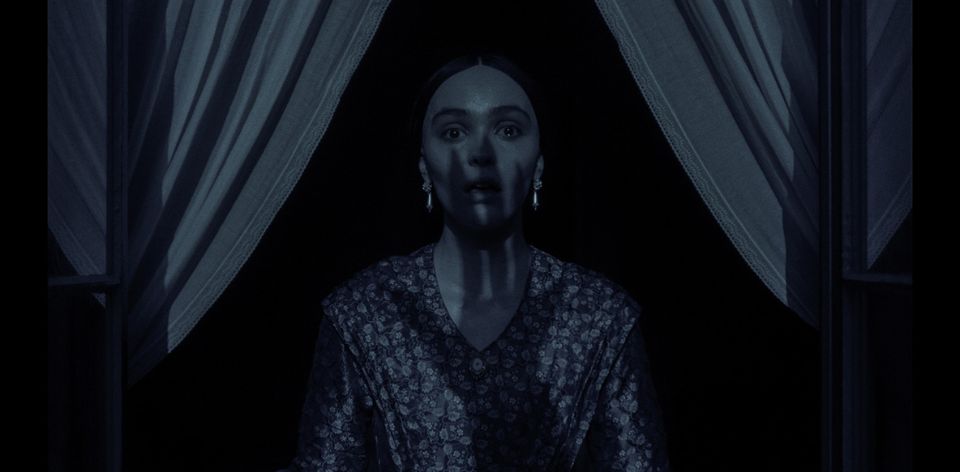When F.W. Murnau’s Nosferatu premiered in 1922, Bram Stoker had only been dead for a decade, and Hollywood was still nearly ten years away from its own adaptation of Dracula. Each version honoured the horror of Stoker’s novel in distinct ways, spawning a century of imitators. Even single chapters, like the voyage of the Demeter, got their own film. Now, over 100 years later, Robert Eggers draws on this rich visual tradition to craft something uniquely his own, paying homage to the past while forging unique ground in the vampire mythos.
If you’ve encountered any version of this tale, the broad strokes will feel familiar. It’s Germany, 1838, and newlywed Thomas Hutter (Nicholas Hoult), ignoring the emphatic warnings of his wife Ellen (Lily-Rose Depp), is sent by his firm to Transylvania to personally seal a deal with the mysterious Count Orlok (Bill Skarsgård). Cue the nightmares.
As Hutter wrestles with both literal and figurative demons in his bid for freedom, Ellen is overcome by prophetic visions and bouts of somnambulism that link her to Orlok. Her friends Anna (Emma Corrin) and Friedrich Harding (Aaron Taylor-Johnson) reluctantly enlist the help of Professor Albin Eberhart Von Franz (Willem Dafoe), a scientist with a fixation on the occult. Meanwhile, their German town is ravaged by plague as Orlok and Ellen find themselves inescapably drawn together by the force of fate.
So, while the shopfront is the same–and it’s an almost aggressively traditional retelling of the tale at that–Eggers has unquestionably put his unique stylistic stamp all over this. From the moment Orlock’s gravelling, bass-infused voice comes booming through the bottom end of the sound system. This is Gothic with a capital G, with the aesthetics of the silent era filtered through a myriad of touchpoints from across the ages.
The German Expressionism of Murnau is present in the black and white tones that seamlessly give way to colour splashes. It’s there as Orlok’s shadow fingers stretch across a patchwork city and in the stairs and angles that mirror the 1922 designs of artist Albin Grau. Like that film and Francis Ford Coppola’s Bram Stoker’s Dracula, occultism and satanic symbolism is present at every turn. Combined with the low, unsettling rumble of the sound design and Robin Carolan’s haunting score, Eggers conjures a visceral terror akin to what audiences must have felt a century ago.
If NOSFERATU stumbles, it’s in its treatment of its female characters. Ellen and Anna—or Mina and Lucy, for the traditionalists—are confined to roles that remain disappointingly defined by the original text. Decades of reinterpretations, from Herzog to Coppola, have largely followed the same patterns, and Eggers’ script does little to disrupt them. Whether they’re depicted as naked riders or sexualised bait, the women serve more as pawns in a male-dominated narrative than as agents of their own destinies.
That said, this doesn’t diminish Depp’s performance one iota. Even within the constraints of the role, she commands attention with a magnetic presence. Dafoe, by now a fixture in Eggers’ eccentric gallery of players, brings both gravitas and surprising levity, delivering even the most outlandish lines with an earnestness that makes them work. Taylor-Johnson, however, feels slightly out of place, as though a contemporary action hero has wandered into Eggers’ meticulously crafted Gothic past.
As the film races toward its dawn conclusion, the grotesqueries of raw vampiric shapes are thrust into the light of day, exposing their absurdity as much as their terror. This duality—both reactions seemingly intended—is a fitting finale. The ending doesn’t tease a Son of Nosferatu or hint at hands clawing out of graves in mid-credits. Instead, the story closes its loop, cementing Gothic horror firmly back at the top of the cinematic mantle where it belongs.
2024 | USA | DIRECTOR: Robert Eggers | WRITERS: Robert Eggers (Based on Nosferatu by Henrik Galeen) | CAST: Bill Skarsgård, Nicholas Hoult, Lily-Rose Depp, Aaron Taylor-Johnson, Emma Corrin, Willem Dafoe | DISTRIBUTOR: Universal Pictures (Australia), Focus Features (USA) | RUNNING TIME: 132 minutes | RELEASE DATE: 1 January 2025 (Australia), 25 December 2024 (USA)






